

 Rheumatoid arthritis is a painful, degenerative disease characterized by
inflamation of the joints and degradation of bone and cartilage surrounding the
joints. It is an invasive disease which criples approximately 2.1 million people worldwide, including children and adults. A prominent symptom is the non-uniform loss of joint space, and deformity due to the inflammatory changes in the ligaments and supporting structures of the joints.
There is no cure for the disease, and the exact mechanism that triggers it is
unknown.
Rheumatoid arthritis is a painful, degenerative disease characterized by
inflamation of the joints and degradation of bone and cartilage surrounding the
joints. It is an invasive disease which criples approximately 2.1 million people worldwide, including children and adults. A prominent symptom is the non-uniform loss of joint space, and deformity due to the inflammatory changes in the ligaments and supporting structures of the joints.
There is no cure for the disease, and the exact mechanism that triggers it is
unknown.
For detailed information on symptoms and diagnosis, try Arthritis Presentations, or see a chart showing the types of arthritis according to symptoms.
Current research indicates that the main cause of rheumatoid arthritis is due to an autoimmune response, in which the immune system's T-cells attack the body's own proteins due to their inability to recognize "self from nonself".
The immune system is a highly organized set of complex steps by which antibodies recognize and destroy invading antigens that pose a threat to cell life. Foremost in this system are T-Cells which bind directly to antigen-bearing cells. T lymphocytes have two receptor sites: one binds to the foreign antigen and the other binds to a familiar antigen.A short description of the immune response and other related topics are found in Immunological Memory.

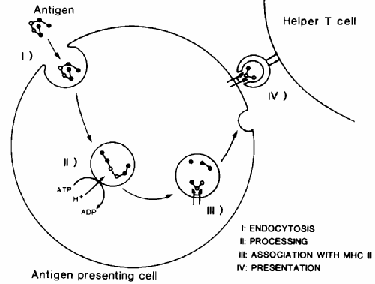
This interaction occurs only with HLA molecules which form part of the human major histocompatibility complex. HLA molecules are cell surface proteins that aid in presenting foreign antigens to T cells. In particular, HLA class II molecules, which present antigens to T helper cells have been implicated in contributing to the autoimmune response in rheumatoid arthritis. HLA class II molecules have a limited distribution. However, the joints of patients with rheumatoid arthritis have abnormal numbers of cells having these molecules on their surface. It is believed that the activated T-cells produce other molecules which directly induce production of more HLA class II molecules. These HLA molecules will be incorporated on the surface of synovial cells, which make up the lining of joits. In this manner protein fragments from synovial cells are free to bind to HLA class II molecules and induce an immune response targeted against synovial cells. Immunotech makes HLA molecules and provides a listing and further information.
Degradation of cartilage and bone are characteristic in late stages of rheumatoid arthritis. Proteins that bind calcium are believed to induce macrophage production, which in turn may affect the process of cartilage degradation. Two such proteins have been discovered in abnormal abundance in the inflammed tissues of arthritic patients. Although the direct mechanism by which these proteins affect inflammation is not yet known, these findings open new doors for future research.
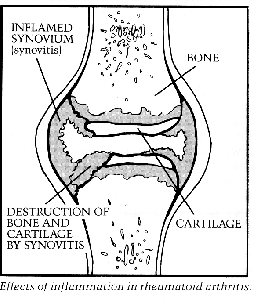
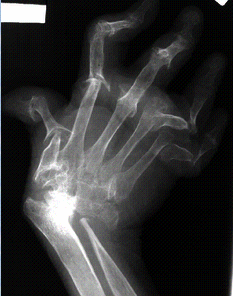
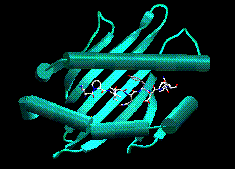
Therapy and treatment available for rheumatoid arthritis are aimed primarily at relieving symptoms. One of the most aggressive therapies involves monoclonal antibodies. This technique isolates and clones a single type of lymphocyte whose antibodies bind to antigen of a particular kind of cell. They are then used to target the T cells which are thought to be a major factor in the development of rheumatoid arthritis. Previously, rodent monoclonal antibodies had been used with adverse immune responses. To see a reluctant mouse give its "all" for monoclonal production,"squeak" here. Now human monoclonal antibodies are used and results indicate a rapid decrease in lymphocyte count and a reduction of joint swelling. AGEN has an interesting list of monoclonal antibodies.

There are many drugs currently available for treatment of rheumatoid arthritis. these include nonsteroid anti-inflammatory drugs (NSAIDs), Disease-modifying antirheumatic drugs (DMARs),immunorepressive agents, and corticosteroids.
NSAIDs, which include aspirin, usually relieve symptoms for only a short time, lasting up to 24+ hours. The most common side effect is gastric irritation. For a detailed listing of these drugs and their possible side effects, go to NSAIDs
Disease-modifying antirheumatic drugs are diverse and their effects can last up to two years. However, they are not as effective with passage of time, and there are varied adverse reactions. A list of these drugs and their effects is found here
Immunorepressive drugs are being used more widely since the discovery of autoimmune deficiency in rheumatoid arthritis. These drugs have not proven to be clinically beneficial in relation to the immune response they might suppress. Furthermore, they are all highly toxic and must be monitored carefully.
Corticosteroids are very effective in suppression of inflammation, but some of the side effects, such as increased osteoporosis, actually aggravate the disease. More about corticosteroids.


No extensive research has been conducted in relation to diet and exercise. One of the few aspects of diet that has received attention is the use of supplemental fish-oil fatty acids to relieve inflammation. A good source of information about the benefits of fish oils can be accessed by clicking Fish Oil. Although results don't point to a general dietary formula, benefits may be patient-specific and deserve more attention. For helpful guidelines about diet and its effects on rheumatoid arthritis:

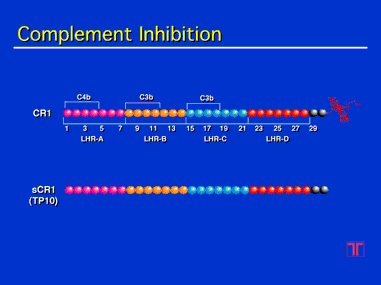
Rheumatoid arthritis represents an uphill battle both for those who suffer its effects and the researchers who are trying to find the mechanisms of an immune system gone awry. Recombinant DNA technology has been used to isolate and amplify genetic factors which may be at the root of this disease. Available drug therapy is the only real relief for most patients. The often toxic side effects remind us that we need to continue more aggressive research.
T Cell Sciences is currently conducting research on the "complement system", which involves proteins that will initiate an inflammatory response. The main strategy is to inhibit this respose. There is a pressing need to find the cause of this crippling disease in order to offer permanent relief to millions. Latest news and research directions about arthritis are provided by The Arthritis Foundation.
 CSULA LibraryLogin as Library
CSULA LibraryLogin as Library
 MELVYL
MELVYL
 CARL
CARL



 References
ReferencesThe following has been added by the Electronic Desktop Project:
 Contact Us
Contact UsIf you are an educator who is using our NEXTSTEP or virtual applications in the classroom, we would especially like to hear from you. Let us know what you are doing and how it is working out. Continued support for this project will depend on its impact in science education.
If you are an educator who is interested in making use of our NEXTSTEP or virtual applications, please let us know how we can help.
 Return to the Electronic Desktop Project home page
Return to the Electronic Desktop Project home page
![]() Check out the WWW Virtual Application Catalog from the EDP
Check out the WWW Virtual Application Catalog from the EDP
 Check out the NEXTSTEP Application Catalog from the EDP
Check out the NEXTSTEP Application Catalog from the EDP
 Visit the home page for California State University, Los Angeles
Visit the home page for California State University, Los Angeles